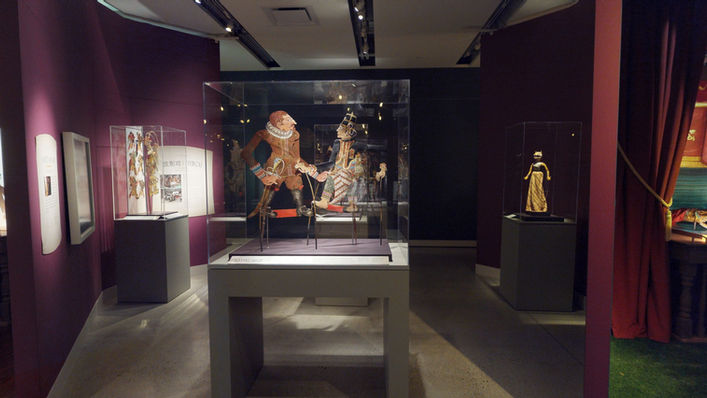
Shadows, Strings & Other Things
The Enchanting Theatre of Puppets
Hands—twitching strings, manipulating rods, moving parts—bring puppets to life. The creative intimacy between the puppeteer and their puppet can dissolve the separation between the two. As energy flows—through veins and wires, flesh and wood, muscles and silicone—the enchantment begin and stories unfold. Five theatrical stages each focus on a specific type of puppet: shadow, string, rod, hand, and stop motion.

At the entrance, you are welcomed by the 12-foot-tall puppet, called Meh.

String puppets or marionettes are in many ways the most complex of puppet forms. Strings, wires or lines are attached to their articulated body parts: heads, arms and legs; sometimes joints, eyelids, and mouths.
The puppets are manipulated from above: the strings are usually threaded, looped and knotted through a handheld device. The more strings, the more nuanced their movements are. Their faces can express different emotions: happiness, surprise, anger, and sorrow. Likewise, their bodies can move, gesture, and dance in a dramatic manner. The realism of the string puppet enables viewers to suspend their disbelief and journey with these storytelling characters.

Shadow puppetry is an enchanting form of storytelling that originated in China and India over two-thousand years ago. It is now found in many parts of the world and entertains crowds with popular tales of misadventure and religious epics. In shadow play, the puppeteers are hidden behind a screen of white cloth and a light-source hangs overhead. As the puppeteer manipulates the puppets, the shadow characters come to life.
The renowned shadow puppets of China, India, Indonesia, and Turkey are made of animal hide; many are intricately cut and dyed or painted so they cast tinted shadows on the screen.

Rod puppets are operated from below, rather than from above like their stringed counterparts. The rod-puppet’s head is generally attached to a central wooden or metal rod, which the puppeteer holds. Smaller rods may be attached to the puppet’s arms to allow a wider range of gestures.
Vietnamese water puppets, like those on the stage, are a unique type of rod puppetry. Their central rod does not extend vertically, out of the puppet’s body. Rather it is attached to a mechanism at the base of the puppet and it extends horizontally, underneath the water to the puppeteer, who is hidden from sight.

Hand puppets come in different shapes and guises, but they all rely on direct manipulation by the human hand--no strings, no wires, no rods, or sticks predominate. Some hand puppets are elaborate, limbed and winged characters who perform in ceremonial and theatrical contexts. But the majority of hand puppets, found throughout the world, assume a simpler shape and form. These hand or glove puppets are relatively small, totally portable, worn on the hand and carried in a case. They may belong to itinerant puppeteers, who perform in public spaces: on streets, in fields, at festivals and fairs, for religious events and seasonal shows.

Stop-motion animation is a time-intensive yet magical form of puppetry which dates back to the late 19-century and the early days of film. Nowadays, the faces and bodies of puppets are frequently made of silicone with flexible joints.
With a storyboard as reference, the puppeteer positions the puppets in a set and photographs the scene. The puppeteer then moves the puppets slightly and exposes them to a second frame. This staged process continues, with tens of thousands of incremental movements and shots, until the story ends. Finally, when the frames are played in sequence, the illusion of movement is created, and the puppets come to life.
puppets that didn't arrive in time for the exhibition
The Mamulengos from brazil
A coulorful uniqueness marks the faces and costumes of the Brazilian mamulengo puppets. The collection consists of a colourful empanada (pop-up booth) and 62 puppets, made by ten different makers, from three different areas in northeastern Brazil. Furthermore, the uniqueness of each puppet is enhanced by the individual characteristics of the block of mamulengo wood from which the puppet takes form. These makers believe that the mood of those who carve the puppet can also influence its expression: "For most makers, if you're angry, [the mamulengo] will end up with an angry face. But if you're happy, the puppet will end up looking prettier." Unfortunately for the exhibit these puppets did not arrive until after the exhibition opened and can not be found in the VR.

















































































































